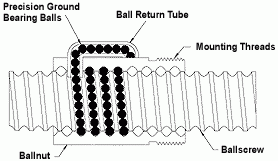Ball Screw Basics
Ball Screws, first invented in the late 1800s, did not come into widespread use until the 1940s when they were adapted for use in the automotive steering gear. Since that time they have been used in a variety of industrial and commercial applications due to their high efficiency and predictable service life (see our inventory here).
Ball Screws utilize a series of ball bearings between the screw and nut threads so that movement is achieved through rolling friction (see Figure 20). Power Screws and Ball Screws are analogous to bushings (sometimes called plain bearings) and ball bearings. Like ball bearings, Ball Screws exhibit low friction and predictable service life. Screws, nuts, and balls are made of heat-treated steel to optimize performance and resist Hertzian stresses.
Efficiency for these screws is 90% and does not vary with load. Because of their high efficiency, they are never self-locking. A holding brake is necessary to sustain loads as they can easily convert thrust to torque and backdrive a gearbox or motor or other drive system elements.

FIGURE 20